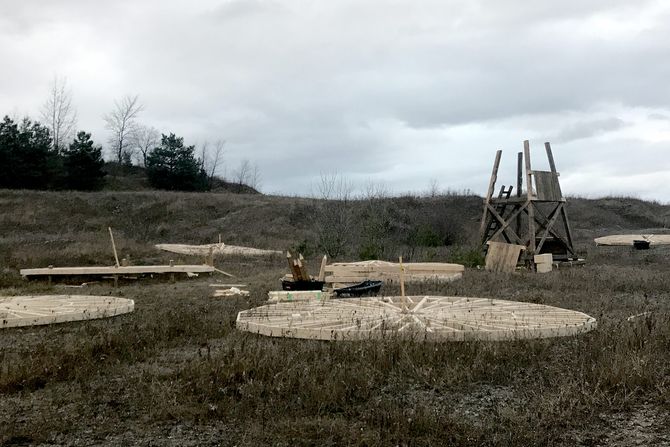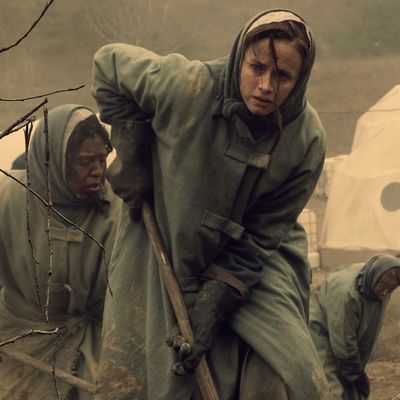
Bruce Miller, showrunner of The Handmaid’s Tale, doesn’t mince words about the time he spent on the Colonies set built for the second season of the Hulu series: “Oh God, it was a misery.”
In Margaret Atwood’s novel, there aren’t a lot of details about the Colonies, a terrifying camp where failed handmaids, criminals, and other undesirables are banished until their deaths. So when the writers and producers set out to create that harrowing world, they spoke with Atwood about what she’d imagined and left out of her book, and then researched how labor camps in Thailand, China, and Russia were run. Though Miller had all those details in his head and in the script, he was still taken aback when he arrived at the site, located north of Toronto.
“It was impressive, but also hilariously, as the writer, you feel guilty because you’ve written something, and now that it’s realized in real life, I was happy because it was so terrible,” Miller said. “I had so much mud all over me. There was no place to go that wasn’t muddy. Then it rained, and then it was freezing. All I can say is Alexis Bledel is a tough, tough motherfucker.”
In “Unwomen,” the second episode of season two, fans see for the first time what happened to Emily (Bledel) after she was expelled from Gilead for running over and killing a Guardian. Her life was spared, but she is sentenced to slave labor, cleaning up toxic waste in the radiation-soaked countryside. “These are people who are discarded from society and forced to work in the fields until they die,” Miller said. “Everything has been stripped away — their names, their families, their identities, and now even their gender because they call them ‘Unwomen.’”
All of the scenes in the Colonies were filmed over a two-week period last November and December — an undertaking that required the regular cast, 98 extras, and 200 crew members to pull it off. In addition to Miller, Vulture spoke to several of the key players who helped bring this new aspect of the Handmaid’s Tale story to life.
The Set Design
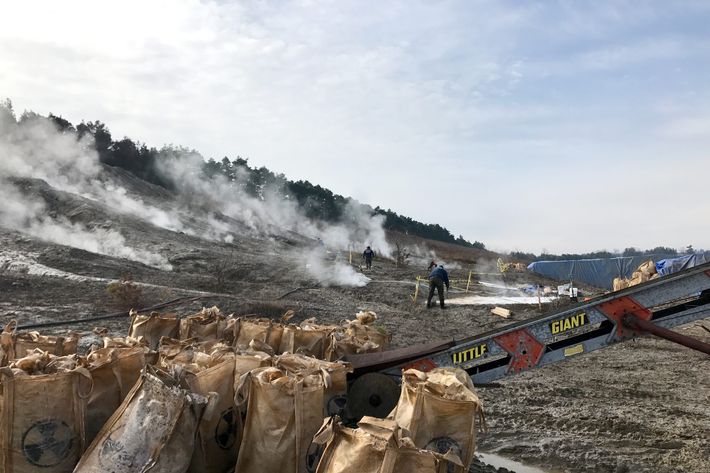
The outdoor pit where the Unwomen are forced to labor was created in an old quarry in Uxbridge, Canada, about 50 miles north of Toronto, while the scenes in the barracks were built in a barn on a working farm closer to Toronto. “It was absolutely beautiful — the setting was perfect,” says set designer Elisabeth Williams. “In our minds, we created a map. The women walk to and from work and the guardians are on horseback, suggesting that even the area where they live is contaminated. They’re basically in this world where everything will kill them.”
Production built a road to access the quarry. For the muddy pit, Williams and producers researched environmental disasters, particularly the nuclear disaster at Fukushima Daiichi in 2011. “In that tragedy in Japan, they cleared the waste and put it in bags and stockpiled the bags into these huge mounds,” said director of photography Colin Watkinson. “That’s how we got the idea for the mounds. Because we needed some kind of texture, we buried pipes [along the sides of the quarry] and had steam coming out of the ground to make pits of toxicity, which the girls broke into with their shovels. It broke up like a crust.”
The trees were painted rustic red to make the background look as toxic as possible. “I made the actors roll around in the mud because they weren’t dirty enough,” director Mike Barker said. “It was soaking wet because of all the steam and we were on the side of a very steep hill, so grappling with the environment was wild. It was minus-16 with the wind chill. If it had rained more than it did, we would have to abandon it because just keeping the actors on the side of the hill was hard enough.”
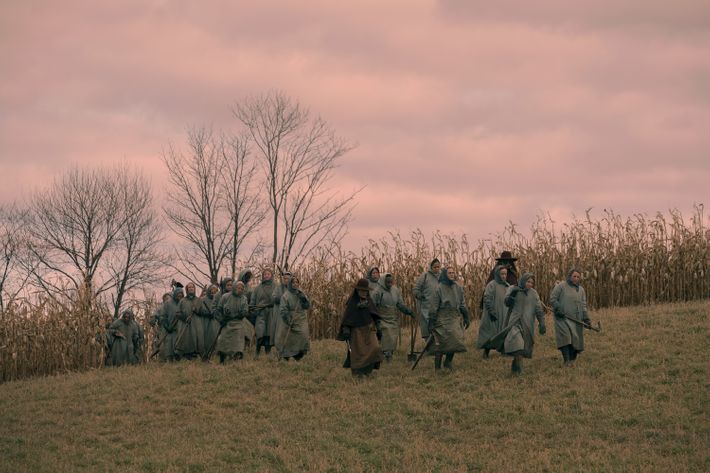
The idea is that the women must dig up the top layer of the contaminated soil so that Gilead can later reuse the land to grow food. “It’s like a lot of penal farms or slavery-type situations, where human bodies are used as a tool to work the soil,” Williams said. “It’s a very inexpensive way to basically reclaim the Earth. You don’t use machinery; you use humans who are considered useless to society and you make them work until they die.” Considering how dark that is, they also didn’t want the Colonies to feel too apocalyptic. “The idea was to have it in more of what we consider a bucolic setting,” Williams said. “We have shots at sundown, and the sun is setting over this golden landscape and these women in light blue dresses are there. There’s something very pretty about it and, at the same time, quite horrific. The idea was that, with this kind of contrast, it leaves the audience with a sense of dread.”
To heighten the feeling of anxiety, Watkinson used a handheld camera during scenes with Bledel and Marisa Tomei, who plays a banished adulterous wife, so the audience would experience the horror right alongside their characters. Minimal lighting was used outdoors to set the mood. “The Colonies also gave us a chance to get up and out and give scope,” Watkinson said. “We took a crane in there so we could try and see as far down as possible and make the Colonies feel much bigger than they actually were.”
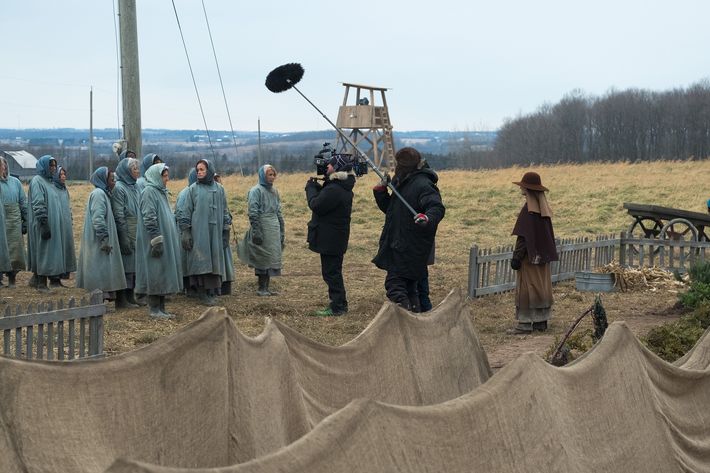
Before they built the living quarters, hay was removed from the top floors of the barn and pigs that lived on the bottom level were relocated. Then the crew reinforced the floors, built interior walls, added stairs to create more levels, and rigged up lighting. “It was a leaky old barn in the middle of nowhere and it was so cold filming there,” Barker said. “The poor girls were freezing.”
It was important, Williams added, to remind the audience that the Gilead regime has taken over existing buildings. “Nothing is built for the pleasure of building it,” she said. “The idea is that we’re going back to basics and therefore we’re recycling as much as we can. We referenced a lot of communal living from various gulags. We used a lot of army beds and blankets. It looks like everything is functional and quickly thrown together to avoid extra costs.”
Chopped feathers were blown around the barn and its exteriors to create a sense of dirty air and toxicity. “You see things dripping down all of the time — they were feathers, but the idea was that they were toxic particles floating in the air,” Barker said. “But in the scene were Emily picked mint, those weren’t feathers. That was brutal snow. Alexis was there bare-shouldered and not one whisper of a complaint.”
Making it as windy as possible was Miller’s idea. “It was very important to me,” he said. “There’s something about that that’s just kind of awful. This a horrible place that is the portal to hell.”
The Costumes
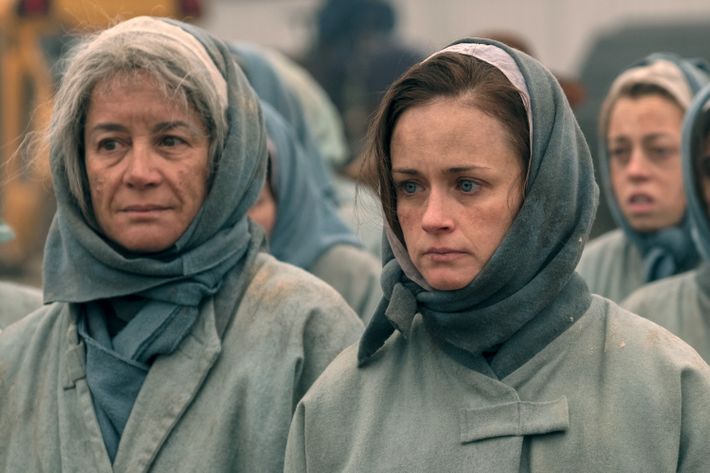
After creating the signature Handmaids’ look — the red gown and wings that earned designer Ane Crabtree an Emmy nomination and became revolutionary symbols in the real world — she wondered if she could outdo herself. “Every person, it doesn’t matter how confident you are, you always worry that lightning doesn’t strike twice, so I really went through a lot of creative insecurity, honestly, and then finally realized no one’s interested in your insecurity.” Crabtree eventually zeroed in on a phrase that kept popping up in her head when she thought of the Colonies: this bitter Earth. When she googled her “visual slang,” the first entry was a mash-up of Dinah Washington’s “This Bitter Earth” with Max Richter’s “On the Nature of Daylight.” “This song of Washington’s was so beautiful, so haunting, full of strings, which always get me going. It felt so clearly to me as if Dinah Washington was an Unwoman speaking and singing these words in the Colonies. It took hours and hours on a Saturday of having that song on repeat and sketching.”
Crabtree looked at more than 800 images of paintings and photographs to discern the color of the new costumes, which is significant in the story since color signals each woman’s tribe. “I didn’t want it to be too close to the wives’ teal or the Martha’s green. So I was worried about what color is next,” she said. Crabtree imagined the sky and Earth melding together in winter for the faded, light-blue costumes. “It’s when things lose their color, almost to the point of death in nature. So they have a hint of color to show there’s a little bit of hope left,” she said.
During her research, Van Gogh’s paintings of potato farmers working in the fields reminded Crabtree how farmers become part of the landscape as they toil in the fields. “In the Colonies, the earth itself has been raped of any nutrients. They’re surrounded by radiation, so even though the Van Gogh paintings are quite bucolic and have pastoral beauty, if you take that but take out the color, you have the Colonies in my brain,” she said. “The important thing, for me, was that the women blend in but have a tinge of color, to have a tiny bit of color left in their dresses because they’re not dead yet.”
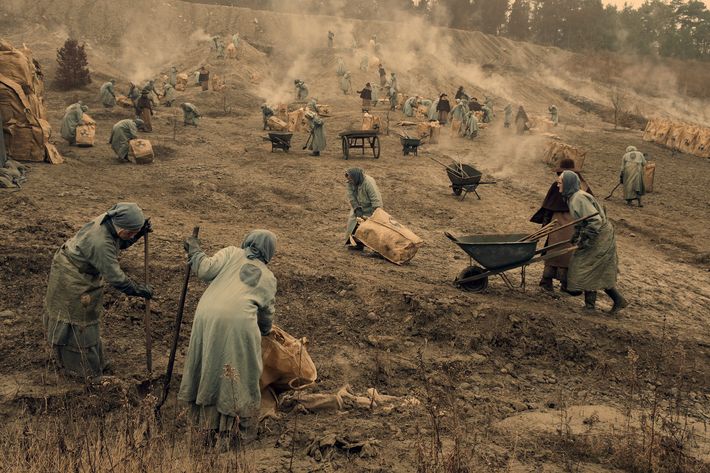
When the production schedule shifted from June to September, Crabtree redesigned the costumes for winter, adding a wool coat and layers that are invisible to the camera. “It had to be one costume with many layers for the winter,” she said. “But we always had the empty zero on the back of their aprons and their coats because that’s what stands for the Unwoman.” She also researched uniforms in different industries of different cultures to make it look as real as possible. “You know those woven bags that you put produce in when you’re picking vegetables or coffee beans? They’re very faded. We used that as a covering for the fabric to keep it dry. It was something to protect against wind, but also to use as an apron over a coat. It would keep them dry in the rain and the mud, which we had plenty of in that location.”
Because the air and soil in the Colonies is filled with radiation, the Aunts, Guardians, and even horses wear gas masks. “The inspiration for the Aunts came from a city mouse/country mouse idea in the costumes,” Crabtree said. “The Aunts and Guardians also exist in the city, which is Gilead. The city cousins have a more regimented uniform, one that doesn’t show wrinkles or keeps its formality.” In the Colonies, the Aunt and Guardian uniforms are more worn, sun-bleached, and covered in mud. The fabrics are softer and wrinkle more easily. “I’m trying to express the idea of radiation, an even more current Fukushima, where the environment takes over man and mankind. Underneath the wide-brimmed hats that the Aunts wear is a flap of fabric to keep away the dust and prevent windburn. I am constantly trying to come up with an invention, literally, in the mind’s eye of a Commander who created all of these worlds. I am a commander dreaming up clothing that will last through desperate situations and weather-worn worlds.”
The Makeup
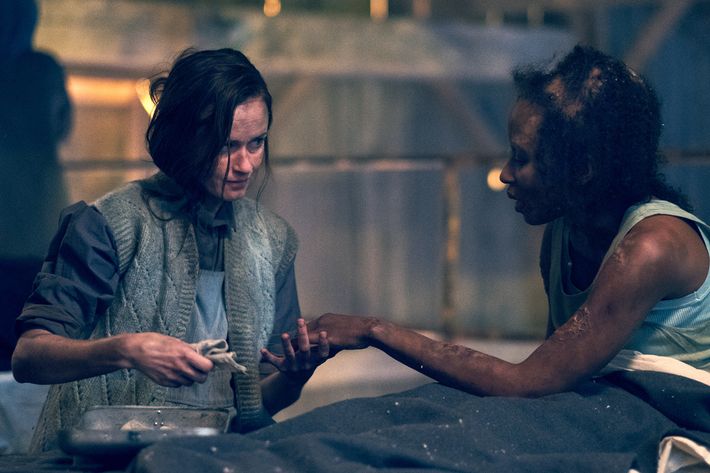
All of the women sent to the Colonies will eventually die from exposure to radiation so Burton J. LeBlanc, who heads the show’s makeup department, considered their different stages of health as he planned how they would look. In stage one, the women have been in the Colonies for one to two weeks with dark circles under their eyes, sallow skin, and a discolored skin tone. In stage two, the women have been living there for three months. “So Emily (Bledel) has more broken skin and raised areas on the cheeks,” LeBlanc said. In stage three, the women have been living there for six months and have open wounds, raw skin, and dry, cracked hands that peel. With 98 extras and the regular cast to prepare, LeBlanc hired one makeup artist per six or seven women and set them up in stations under a heated tent according to each character’s stage of life.
It took about 45 minutes to an hour to do Bledel’s makeup. LeBlanc used Dermaflage scar makeup for the discoloration and raised areas on Emily’s face and a product called Maekup to make her appear sun- and windburned. “They’re out in the fields working in the sun and all the elements and nobody cares about them so they’re just out there in the bright sun and the heavy wind. Maekup has a sunburn product that we spray around the nose and forehead and another one to dry the lips so they’ll appear cracked.”
Since Marisa Tomei’s character only lives in the Colonies for two days, the most challenging part of her makeup process was lightening up her “California tan.” “She looked great so I had to take it down and pale her out and make her more sallow and give her some darkness around the eyes,” LeBlanc said. “We also gave her a little bit of grime since she worked for two days in the soil.”
Tomei’s character meets a surprising fate at the hands of Emily, who appears to befriend her but actually poisons her. LeBlanc colored Tomei’s lips blue and grayed her skin tone for the gruesome scene in which she is hung like a scarecrow. “There was some dirt and discoloration on her face, but she hadn’t been there that long and she died from her internal injuries, so I didn’t have to do that much.”
See behind the scenes images from the set of the Colonies:
